I need to take the ol’ Retroplex Cruiser time machine to my mechanic for its scheduled 10,000-year maintenance, but I think it’s good for one more quick trip back in time. In December we traced the changes that occurred through the years to the block bounded by Main and Houston, 3rd and 4th streets. Today that block is the western half of Sundance Square Plaza.
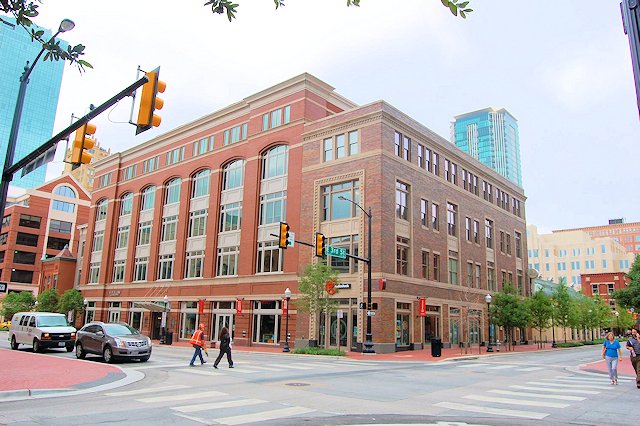 This is the Commerce Building, which today anchors the eastern half of Sundance Square Plaza at the corner of 3rd and Commerce streets. Now climb into the Retroplex Cruiser and buckle up while I set the destination date for 1890. We are going to travel back in time to this corner 130 years ago.
This is the Commerce Building, which today anchors the eastern half of Sundance Square Plaza at the corner of 3rd and Commerce streets. Now climb into the Retroplex Cruiser and buckle up while I set the destination date for 1890. We are going to travel back in time to this corner 130 years ago.
Ready? To the past, and step on it! . . .
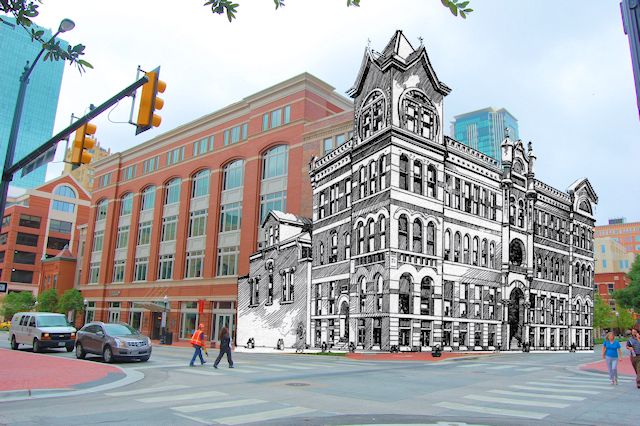 . . . Whoa, Nelly Belle! That was fast. I think we picked up a tailwind as we passed through Teddy Roosevelt’s years in office. Okay. Here we are in 1890. Bustles and buggies. Wooden sidewalks along unpaved streets. Look at that big, handsome building on the corner of 3rd and Rusk. (Commerce Street was named “Rusk Street” until 1909.) That building is Fort Worth’s new Nat—short for “Natatorium” (from natare, Latin for “swim”). But back in 1890 the Nat was much more than an indoor swimming pool. Most homes in Fort Worth did not have indoor plumbing. The “smallest room in the house” was actually the smallest building in the back yard—an outhouse. And folks back then might bathe just once a week. In 1890 you typically took a bath in a big metal or wooden washtub (or hip tub) that hung on a wall all week until you dragged it to the kitchen or the back porch and filled it with water that you had pumped from a well and heated on a wood-burning stove. After your bath, you had to lug the tub outdoors and tump it over to empty it and then drag it back into the house and hang it back on the wall until next week. (1890 engraving from Pete Charlton.)
. . . Whoa, Nelly Belle! That was fast. I think we picked up a tailwind as we passed through Teddy Roosevelt’s years in office. Okay. Here we are in 1890. Bustles and buggies. Wooden sidewalks along unpaved streets. Look at that big, handsome building on the corner of 3rd and Rusk. (Commerce Street was named “Rusk Street” until 1909.) That building is Fort Worth’s new Nat—short for “Natatorium” (from natare, Latin for “swim”). But back in 1890 the Nat was much more than an indoor swimming pool. Most homes in Fort Worth did not have indoor plumbing. The “smallest room in the house” was actually the smallest building in the back yard—an outhouse. And folks back then might bathe just once a week. In 1890 you typically took a bath in a big metal or wooden washtub (or hip tub) that hung on a wall all week until you dragged it to the kitchen or the back porch and filled it with water that you had pumped from a well and heated on a wood-burning stove. After your bath, you had to lug the tub outdoors and tump it over to empty it and then drag it back into the house and hang it back on the wall until next week. (1890 engraving from Pete Charlton.)
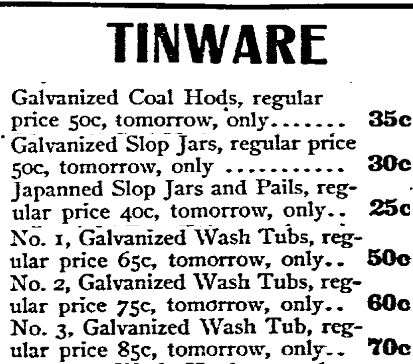
This 1903 Telegram ad for tinware tells us a lot about domestic life at the turn of the century: coal hods (buckets), slop jars and pails (chamber pots), and washtubs, the no. 3 being the biggest at seventeen gallons.
For some people this lifestyle would continue into the 1920s. In his memoirs, The Clod-Hoppin’ Judge: Memoirs of Judge Gerald Parker Brown, Judge Brown (born in 1920) recalled “bath night” of his childhood:

What a rigmarole!
So, entrepreneurs offered commercial alternatives to the washtub: You could take your weekly bath at a barbershop, a bathhouse, or a natatorium. Fort Worth’s new natatorium had twenty-three bathrooms with marble tubs.
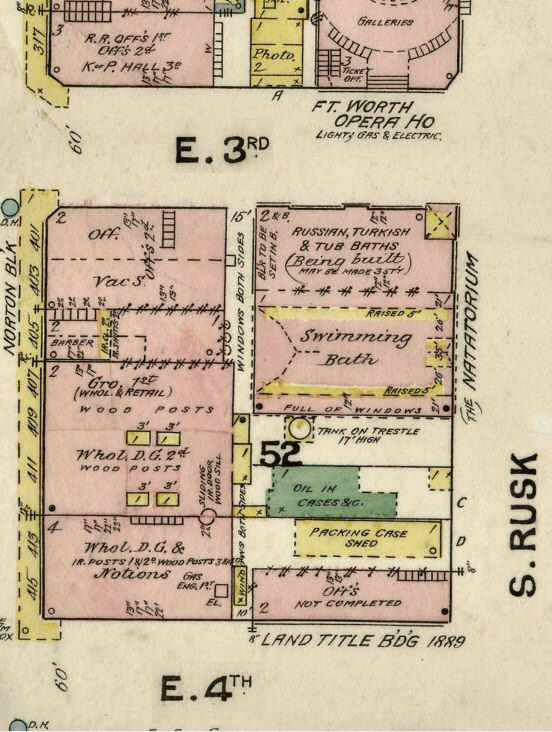 When this Sanborn map was drawn in 1889 Fort Worth’s Natatorium was under construction. Ditto the nearby Land Title Block Building to the south. Both buildings were designed by architects Haggart and Sanguinet. The map indicates a water tank on a tower outside the swimming pool enclosure. Just across 3rd Street were the opera house (1883) and the original Knights of Pythias hall (1881).
When this Sanborn map was drawn in 1889 Fort Worth’s Natatorium was under construction. Ditto the nearby Land Title Block Building to the south. Both buildings were designed by architects Haggart and Sanguinet. The map indicates a water tank on a tower outside the swimming pool enclosure. Just across 3rd Street were the opera house (1883) and the original Knights of Pythias hall (1881).
 And here is the Nat in Greater Fort Worth (1907) and in Henry Wellge’s 1891 bird’s-eye-view map. The Land Title Block Building is to the left. The opera house is to the right.
And here is the Nat in Greater Fort Worth (1907) and in Henry Wellge’s 1891 bird’s-eye-view map. The Land Title Block Building is to the left. The opera house is to the right.
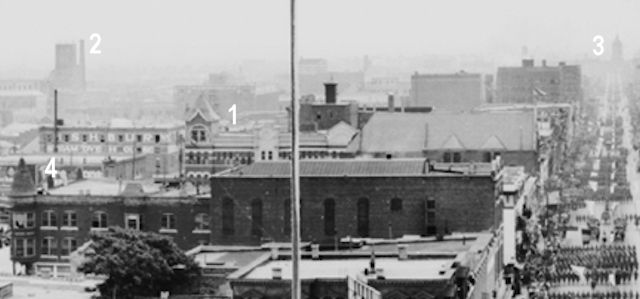 This small detail from a 1918 panorama of Camp Bowie‘s 36th Division on parade on Main Street shows 1. the Natatorium, 2. Texas Brewing Company, 3. the 1899 T&P passenger depot, and 4. the “castle” of serial killer Dr. Henry Howard Holmes. (Photo from Library of Congress.)
This small detail from a 1918 panorama of Camp Bowie‘s 36th Division on parade on Main Street shows 1. the Natatorium, 2. Texas Brewing Company, 3. the 1899 T&P passenger depot, and 4. the “castle” of serial killer Dr. Henry Howard Holmes. (Photo from Library of Congress.)
A company headed by Sam Cantey of the Capps and Cantey law firm dug an artesian well and built the Nat for $100,000 ($2.5 million today). A four-story brick-and-stone edifice with marble floors, it was a marvel to behold in 1890.
 The Nat opened on March 29, 1890. The building had steam heat and electric lights. It included a men-only hotel. It rented rooms for social events. It leased commercial office space. A swimming instructor was on duty. The Nat had a bar and a barbershop. In addition to the 50-by-95-foot swimming pool, the Nat offered “tub, Turkish, and Russian” baths. Clip is from the March 30 Gazette.
The Nat opened on March 29, 1890. The building had steam heat and electric lights. It included a men-only hotel. It rented rooms for social events. It leased commercial office space. A swimming instructor was on duty. The Nat had a bar and a barbershop. In addition to the 50-by-95-foot swimming pool, the Nat offered “tub, Turkish, and Russian” baths. Clip is from the March 30 Gazette.
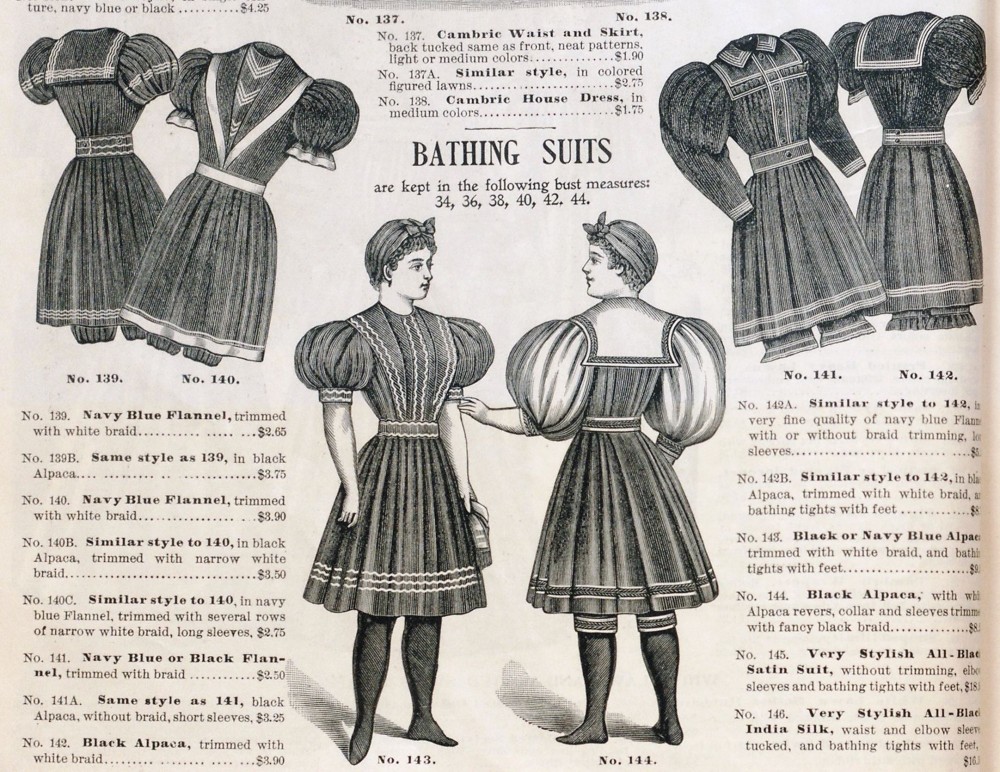
The Nat offered “experienced female help” for the ladies, who had their own entrance on Rusk Street and who might have worn bathing suits such as these in an ad of 1896.
 And the Nat evolved with the times. It added apartments for women. By 1893 it housed an Army recruiting office, according to an ad in the Gazette.
And the Nat evolved with the times. It added apartments for women. By 1893 it housed an Army recruiting office, according to an ad in the Gazette.
 Also by 1893 the Nat was offering to invalids and rheumatics “Electric Baths.” Now an “electric bath” might sound like a one-way ticket to a toe tag, but the Nat boasted that “countless stubborn cases have yielded to the mysterious electric fluid.”
Also by 1893 the Nat was offering to invalids and rheumatics “Electric Baths.” Now an “electric bath” might sound like a one-way ticket to a toe tag, but the Nat boasted that “countless stubborn cases have yielded to the mysterious electric fluid.”
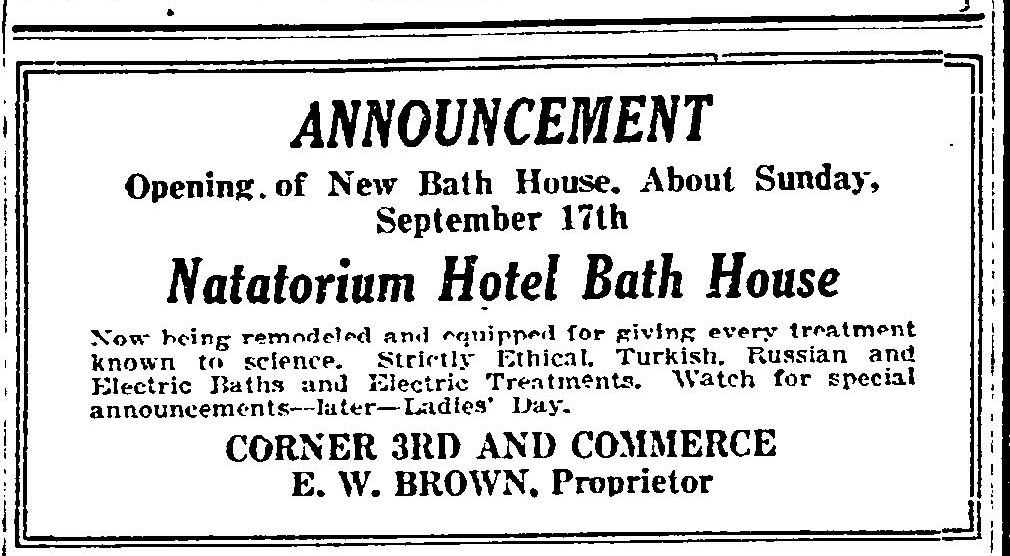 The Nat was remodeled in 1922 (“Strictly Ethical, Turkish, Russian and Electric Baths”) and survived a few more years. But for bathers, indoor plumbing was becoming more common at home. Swimmers, too, now had options: municipal pools, pools at YMCAs and country clubs. And Americans were driving more than they were swimming. They needed more wide, open spaces where they could hitch all those horseless carriages. The Nat was torn down to make way for . . . a parking lot.
The Nat was remodeled in 1922 (“Strictly Ethical, Turkish, Russian and Electric Baths”) and survived a few more years. But for bathers, indoor plumbing was becoming more common at home. Swimmers, too, now had options: municipal pools, pools at YMCAs and country clubs. And Americans were driving more than they were swimming. They needed more wide, open spaces where they could hitch all those horseless carriages. The Nat was torn down to make way for . . . a parking lot.
Everyone out of the pool.
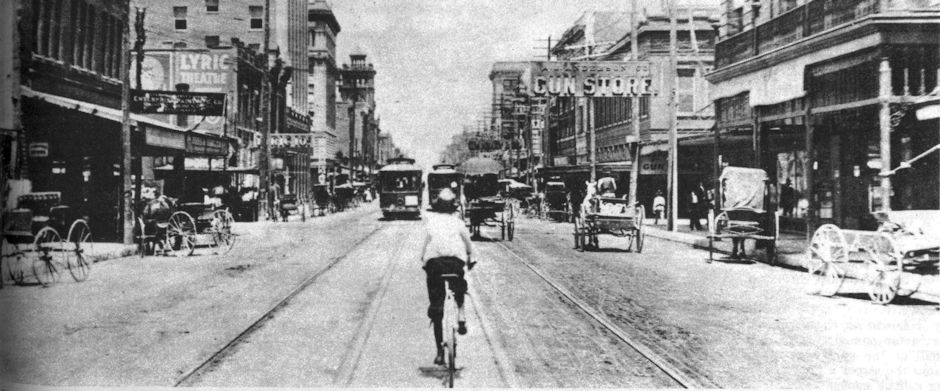





“pave paradise,put up a parking lot”…. This my friends is not progress….
Great stuff Mike! Keep it coming!
Thanks, Deborah. Would love to see photos of the interior.
Oh noooo! Not a parking lot.